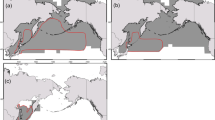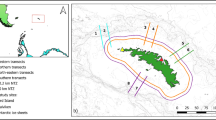Abstract
To control the spread of non-indigenous species it is necessary to understand how early stages of the invasion process, such as age of propagule at time of entrainment and transport, influence the quality and quantity of propagules delivered to recipient environments (i.e., the propagule pressure). Using ship biofouling as a model pathway scenario and the bryozoan Bugula neritina, the effect of two early-stage selective filters—the age of recruits and the pattern of the voyage—on reproductive output post-arrival were examined. Voyage scenarios were created by manipulating food levels in a series of field experiments. Recruit Age had three levels (1-day, 1-week and 1-month), and Voyage Pattern (four levels) represented vessels that undertake frequent short voyages or infrequent long voyages, plus control treatments. Spawning success, number of larvae and larval size were measured over multiple spawning events after each scenario. One-day and 1-week old colonies that had been exposed to short-voyage scenarios had higher reproductive output than those that had been exposed to longer and less frequent voyages. In contrast, 1-month old colonies did not release larvae under any voyage scenario. The survivorship of bryozoans in all treatments was relatively high, but reproductive output was influenced by colony age and voyage type. Our results suggest that vessels undergoing frequent, short intra-coastal or domestic voyages are able to deliver viable propagules to subsequent destinations even if they have prior port residencies as short as 1 day. At least for bryozoans, juvenile recruits may even pose a higher risk of spread compared to reproductively mature recruits.





Similar content being viewed by others
Notes
A propagule is an ecologically relevant unit of dispersal used to move an organism to the next stage of their life cycle. It can refer to many stages including an adult or a larva. Here a propagule is the larva released from a sessile biofouling organism.
References
Ahlroth P, Alatalo RV, Holopainen A, Kumpulainen T, Suhonen J (2003) Founder population size and number of source populations enhance colonization success in waterstriders. Oecologia 137:617–620. doi:10.1007/s00442-003-1344-y
Anderson MJ (2001) Permutational test for univariate or multivariate analysis of variance and regression. Can J Fish Aquat Sci 58:626–639
Anderson MJ, Gorley RN, Clarke KR (2008) PERMANOVA+ for PRIMER: guide to software and statistical methods. PRIMER-E Ltd, Plymouth
Ashton G, Davidson I, Ruiz G (2014) Transient small boats as a long-distance coastal vector for dispersal of biofouling organisms. Estuar Coasts 37:1572. doi:10.1007/s12237-014-9782-9
Bell JB (1993) Feeding and growth of prosobranch veligers. University of Hawaii, Honolulu
Boltovskoy D, Sylvester F, Otaegui A, Leites V, Cataldo DH (2009) Environmental modulation of reproductive activity of the invasive mussel Limnoperna fortunei: implications for antifouling strategies. Austral Ecol 34:719–730. doi:10.1111/j.1442-9993.2009.01974.x
Carlton JT, Hodder J (1995) Biogeography and dispersal of coastal marine organisms—experimental studies on a replica of a 16th-century sailing vessel. Mar Biol 121:721–730. doi:10.1007/bf00349308
Childs DZ, Metcalf CJE, Rees M (2010) Evolutionary bet-hedging in the real world: empirical evidence and challenges revealed by plants. Proc R Soc B Biol Sci 277:3055–3064. doi:10.1098/rspb.2010.0707
Clark GF, Johnston EL (2005) Manipulating larval supply in the field: a controlled study of marine invasibility. Mar Ecol Prog Ser 298:9–19. doi:10.3354/meps298009
Clark MS et al (2013) Hypoxia impacts large adults first: consequences in a warming world. Glob Change Biol 19:2251–2263
Clarke KR, Gorley RN (2006) PRIMER v6: user manual/tutorial. PRIMER-E Ltd, Plymouth
Clarke Murray C, Pakhomov EA, Therriault TW (2011) Recreational boating: a large unregulated vector transporting marine invasive species. Divers Distrib 17:1161–1172
Clarke Murray C, Therriault TW, Martone PT (2012) Adapted for invasion? Comparing attachment, drag and dislodgment of native and nonindigenous hull fouling species. Biol Invasions 14:1651–1663
Cohen D (1966) Optimizing reproduction in a randomly varying environment. J Theor Biol 12:119–129. doi:10.1016/0022-5193(66)90188-3
Coutts ADM, Dodgshun TJ (2007) The nature and extent of organisms in vessel sea-chests: a protected mechanism for marine bioinvasions. Mar Pollut Bull 54:875–886
Coutts ADM, Taylor MD (2004) A preliminary investigation of biosecurity risks associated with biofouling on merchant vessels in New Zealand. NZ J Mar Freshw Res 38:215–229. doi:10.1080/00288330.2004.9517232
Cranfield HJ et al (1998) Adventive marine species in New Zealand. Natl Inst Water Atmos Res, Wellington
Dafforn KA, Glasby TM, Johnston EL (2008) Differential effects of tributyltin and copper antifoulants on recruitment of non-indigenous species. Biofouling 24:23–33
Dahms HU, Gao QF, Hwang JS (2007) Optimized maintenance and larval production of the bryozoan Bugula neritina (Bugulidae: Gymnolaemata) in the laboratory. Aquaculture 265:169–175
Dias GM, Marshall DJ (2010) Does the relationship between offspring size and performance change across the life-history? Oikos 119:154–162. doi:10.1111/j.1600-0706.2009.17725.x
Duncan RP (2016) How propagule size and environmental suiatbility jointly determine establishment success: a test using dung bettle introductions. Biol Invasions 18:985. doi:10.1007/s10530-016-1083-8
Estrada JA, Wilson CH, NeSmith JE, Flory SL (2016) Propagule quality mediates invasive plant establishment. Biol Invasions 18:2325. doi:10.1007/s10530-016-1163-9
Floerl O (2002) Intracoastal spread of fouling organisms by recreational vessel. Ph.D. thesis. James Cook University, Townsville, Australia
Floerl O, Inglis GJ, Diettrich J (2016) Incorporating human behaviour into the risk–release relationship for invasion vectors: why targeting only the worst offenders can fail to reduce spread. J Appl Ecol. doi:10.1111/1365-2664.12609
Godwin LS (2003) Hull fouling of maritime vessels as a pathway for marine species invasions to the Hawaiian Islands. Biofouling 19:123–131
Gollasch S (2007) International collaboration on marine bioinvasions—The ICES response. Mar Pollut Bull 55:353–359
Gordon DP, Mawatari SF (1992) Atlas of marine-fouling Bryozoa of New Zealand ports and harbours, vol 107. Miscellaneous Publications of the New Zealand Oceanographic Institute. NZ Oceanographic Institute, DSIR Marine and Freshwater, New Zealand
Hedge LH, Johnston EL (2012) Propagule pressure determines recruitment from a commercial shipping pier. Biofouling 28:73–85. doi:10.1080/08927014.2011.652622
Hedge LH, O’Connor WA, Johnston EL (2012) Manipulating the intrinsic parameters of propagule pressure: implications for bio-invasion. Ecosphere 3:1–13
Hedge LH, Leung B, O’Connor WA, Johnston EL (2014) The interacting effects of diversity and propagule pressure on early colonization and population size. J Anim Ecol 83:168–175. doi:10.1111/1365-2656.12125
Hewitt CL, Campbell ML (2008) Assessment of relative contribution of vectors to the introduction and translocation of marine invasive species. Report prepared for the Department of Agriculture, Fisheries and Forestry. National Centre for Marine Conservation and Resource Sustainability, Australian Maritime College, University of Tasmania. Launceston. 45 pp
Hopkins GA, Forrest BM (2010) A preliminary assessment of biofouling and non-indigenous marine species associated with commercial slow-moving vessels arriving in New Zealand. Biofouling 26:613–621
Hopper KR (1999) Risk-spreading and bet-hedging in insect population biology. Annu Rev Entomol 44:535–560. doi:10.1146/annurev.ento.44.1.535
Husmann G, Philipp E, Rosenstiel P, Vazquez S, Abele D (2011) Immune response of the Antarctic bivalve Laternula elliptica to physical stress and microbial exposure. J Exp Mar Biol Ecol 398:83–90
Inglis GJ et al (2010) The biosecurity risks associated with biofouling on international vessels arriving in New Zealand: summary of the patterns and predictions of fouling. National Institute of Water and Atmospeheric Research, Christchurch
International Maritime Organisation (2011) Guidelines for the control and management of ships’ biofouling to minimize the transfer of invasive aquatic species. London
Johnston EL, Piola RF, Clark GF (2009) The role of propagule pressure in invasion success. In: Rilov G, Crooks J (eds) Marine bioinvasions: ecology, conservation, and management perspectives. Springer, Berlin, pp 133–153
Keough MJ, Chernoff H (1987) Dispersal and population variation in the bryozoan Bugula neritina. Ecology 68:199–210
Koops MA, Hutchings JA, Adams BK (2003) Environmental predictability and the cost of imperfect information: influences on offspring size variability. Evol Ecol Res 5:29–42
Lewis JA, Coutts AD (2009) Biofouling invasions. In: Dürr S, Thomason J (eds) Biofouling. Blackwell Publishing Ltd, London, pp 348–365
Lockwood JL, Cassey P, Blackburn T (2005) The role of propagule pressure in explaining species invasions. Trends Ecol Evol 20:223–228
Lonsdale WM (1999) Global patterns of plant invasions and the concept of invasibility. Ecology 80:1522–1536
Mackie JA, Keough MJ, Christidis L (2006) Invasion patterns inferred from cytochrome oxidase I sequences in three bryozoans, Bugula neritina, Watersipora subtorquata, and Watersipora arcuata. Mar Biol 149:285–295
Marshall DJ, Keough MJ (2008) The evolutionary ecology of offspring size in marine invertebrates. In: Sims DW (ed) Advances in marine biology, vol 53, pp 1–60. Advances in marine biology. doi:10.1016/s0065-2881(07)53001-4
Marshall DJ, Bolton TF, Keough MJ (2003) Offspring size affects the post-metamorphic performance of a colonial marine invertebrate. Ecology 84:3131–3137. doi:10.1890/02-0311
Marshall DJ, Allen RM, Crean AJ (2008) The ecological and evolutionary importance of maternal effects in the sea. Oceanogr Mar Biol 46:203–250
McGinley MA, Temme DH, Geber MA (1987) Parental investment in offspring in variable environments—theoretical and empirical considerations. Am Nat 130:370–398. doi:10.1086/284716
Ministry for Primary Industries (2014) Craft risk management standard: biofouling on vessels arriving to New Zealand, vol 8. Ministry for Primary Industries, Wellington
Murtha JM, Keller ET (2003) Characterization of the heat shock response in mature zebrafish (Danio rerio). Exp Gerontol 38:683–691. doi:10.1016/S0531-5565(03)00067-6
Pechenik JA (1984) The relationship between temperature, growth rate, and duration of planktonic life for larvae of the gastropod Crepidula fornicata (L.). J Exp Mar Biol Ecol 74:241–257
Peck LS, Souster T, Clark MS (2013) Juveniles are more resistant to warming than adults in 4 species of Antarctic marine invertebrates. PLoS One 8:e66033
Pineda MC, McQuaid CD, Turon X, López-Legentil S, Ordóñez V, Rius M (2012) Tough adults, frail babies: an analysis of stress sensitivity across early life-history stages of widely introduced marine invertebrates. PLoS One 7:e46672
Piola RF, Johnston EL (2006) Differential tolerance to metals among populations of the introduced bryozoan Bugula neritina. Mar Biol 148:997–1010
Piola RF, Johnston EL (2009) Comparing differential tolerance of native and non-indigenous marine species to metal pollution using novel assay techniques. Environ Pollut 157:2853–2864
Pochon X, Zaiko A, Hopkins GA, Banks JC, Wood SA (2015) Early detection of eukaryotic communities from marine biofilm using high-throughput sequencing: an assessment of different sampling devices. Biofouling 31:241–251
Schimanski KB (2015) The importance of selective filters on vessel biofouling invasion processes. Ph.D. thesis. University of Canterbury, Christchurch
Schneider CA, Rasband WS, Eliceiri KW (2012) NIH image to ImageJ: 25 years of image analysis. Nat Methods 9:671–675
Simberloff D (2009) The role of propagule pressure in biological invasions. Ann Rev Ecol Evolut Syst 40:81–102
Ső C, Csermely P (2003) Aging and molecular chaperones. Exp Gerontol 38:1037–1040
Sørensen J, Loeschcke V (2002) Decreased heat-shock resistance and down-regulation of Hsp70 expression with increasing age in adult Drosophila melanogaster. Funct Ecol 16:379–384
Velando A, Drummond H, Torres R (2006) Senescent birds redouble reproductive effort when ill: confirmation of the terminal investment hypothesis. Proc R Soc B Biol Sci 273:1443–1448. doi:10.1098/rspb.2006.3480
Williams GC (1966) Natural selection, the costs of reproduction, and a refinement of Lack’s Principle. Am Nat 100:687–690. doi:10.2307/2459305
Zabin CJ, Ashton GV, Brown CW, Davidson IC, Sytsma MD, Ruiz GM (2014) Small boats provide connectivity for nonindigenous marine species between a highly invaded international port and nearby coastal harbors. Manag Biol Invasions 5:97–112
Acknowledgements
We thank The Naval Point Club members for facilitating access to our experimental location in Magazine Bay. Graeme Inglis (National Institute of Water and Atmospheric Research—NIWA) provided helpful discussion and support throughout the research process, and comments on the original manuscript. Becky Focht, Iana Stoliarova and Jan McKenzie provided valuable support with field and laboratory work. This project was funded by NIWA under the Coasts and Oceans Research Programme 6: Marine Biosecurity (2015/16 SCI), and the Cawthron Institute under a Ph.D. scholarship.
Author information
Authors and Affiliations
Corresponding author
Ethics declarations
Conflict of interest
The authors declare that they have no conflict of interest.
Rights and permissions
About this article
Cite this article
Schimanski, K.B., Goldstien, S.J., Hopkins, G.A. et al. Life history stage and vessel voyage profile can influence shipping-mediated propagule pressure of non-indigenous biofouling species. Biol Invasions 19, 2089–2099 (2017). https://doi.org/10.1007/s10530-017-1420-6
Received:
Accepted:
Published:
Issue Date:
DOI: https://doi.org/10.1007/s10530-017-1420-6




